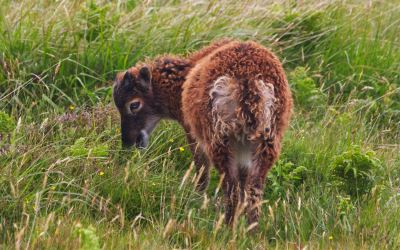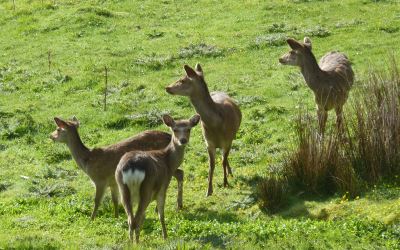As is often the case with small islands Lundy has few naturally occurring species of land mammal, although the island's history is rich with examples of deliberate and accidental introductions, not all equally successful.
Native species
The only indigenous Lundy mammal is the Pygmy Shrew Sorex minutus. These tiny insectivores can be seen in and around the properties but also survive in the natural landscape. In recent years thay have been reported from most properties in and around the village but are not dependent upon human habitation having been seen at Halfway Wall, the Terraces and as far north as North Light.
Bats are occasionally observed on Lundy and are usually assumed to be one of the native pipistrelle species; Common Pipistrelle Pipistrellus pipistrellus or Soprano Pipistrelle P. pygmaeus. A passive detector study by Geoff Billington during 2014 confirmed the presence of these two pipistrelle species as well as Greater Horseshoe Bats Rhinolophus ferrumequinum, in relatively high numbers in May. More unusual species detected during this study included the recently discovered Alcathoe Bat Myotis alcathoe, Nathusius Pipistrelle Pipistrellus nathusii and Barbastelle Barbastella barbastellus. Two species not considered resident in the UK were detected; Kuhl’s pipistrelle Pipistrellus kuhlii and Savi’s Pipistrelle Pipistrellus savii. Other species detected in low numbers included Noctule Nyctalus noctula, Long-eared Bat Plecotus sp. and Myotis species which were not identified to species but one was considered to be a Whiskered or Brandt’s Bat Myotis mystacinus / brandtii.
Introduced species
Rabbits Oryctolagus cuniculus are believed to have been brought to Britain after the Norman conquest and there are written records that they were being taken from Lundy for meat and fur as early as 1183. In the early twentieth century many thousands were killed on Lundy each year, with nearly 11,000 believed to have been taken in 1929 alone. It was still considerd to be 'abundant' during an LFS mammal survey in 1953.
The flea-borne disease myxomatosis first appeared in the Lundy Rabbit population in 1983 more than 25 years after it became prevalent on the nearby mainland and probably through deliberate introduction. Following the initial population collapse numbers have fluctated widely with major outbreaks in 1992 and 1996. As recently as 2013 there were reported to be at least 1000 Rabbits still on the island, but since then numbers have plummeted, with Viral Hemorrhagic Disease (VHD) suspected.
 Soay Sheep Ovus aries of St Kilda are the most primitive domestic sheep in Europe, resembling the original wild species and the domesticated Neolithic sheep which were first brought to Britain in about 5000 BC.
Soay Sheep Ovus aries of St Kilda are the most primitive domestic sheep in Europe, resembling the original wild species and the domesticated Neolithic sheep which were first brought to Britain in about 5000 BC.
Soays were introduced to Lundy in 1942, with additions in 1944 bringing the flock to one ram and seven ewes. By 1953 there were 70 or 80 and in 1995 an island-wide survey counted 278. The Lundy Soays now constitute the third largest closed flock of this breed existing in a feral state anywhere in the world and the largest away from St Kilda. Their grazing is of value in assisting in the maintenance of the semi-natural grasslands and heathlands in the northern parts of the island. The 2010 terrestrial management plan recommended that the population be maintained at 120-150 breeding ewes plus followers providing around 30 lambs for slaughter each year. Recent assessments that put the size of the flock at over 300 animals.
 Seven Sika Deer Cervus nippon were introduced to Lundy in 1927 and increased in numbers, despite regular culling, to around 90 individuals in 1961. Before the Rhododendron thickets were cleared from the east sidelands, Sika would shelter there during the day and would only be easy to see in the early morning or evening. Nowadays they are more obvious but relatively few counts are reported and members are encouraged to enter these in the LFS logbook, held in the Marisco Tavern. The 2010 terrestrial management plan recommended that a population of 30 mature hinds and 10 mature stags would form a sustainable population, without adversely impacting the the semi-natural vegetation communities, with the proviso that these targets are regularly reviewed. Culling is still carried out to manage the population size and provide produce for the tavern kitchen, although numbers are typically in excess of the target. In 2022 the post-breeding population was estimated to be in excess of 130 individuals.
Seven Sika Deer Cervus nippon were introduced to Lundy in 1927 and increased in numbers, despite regular culling, to around 90 individuals in 1961. Before the Rhododendron thickets were cleared from the east sidelands, Sika would shelter there during the day and would only be easy to see in the early morning or evening. Nowadays they are more obvious but relatively few counts are reported and members are encouraged to enter these in the LFS logbook, held in the Marisco Tavern. The 2010 terrestrial management plan recommended that a population of 30 mature hinds and 10 mature stags would form a sustainable population, without adversely impacting the the semi-natural vegetation communities, with the proviso that these targets are regularly reviewed. Culling is still carried out to manage the population size and provide produce for the tavern kitchen, although numbers are typically in excess of the target. In 2022 the post-breeding population was estimated to be in excess of 130 individuals.
 Goats Capra hircus have probably existed on Lundy since the time of its earliest human inhabitants, and it is likely that some of these would have escaped. Further introductions occurred in 1926 and subsequently. Today the population varies between 30 and 50 and all have the typical appearance of wild goats; long-haired with horns. Numbers are controlled to keep the population stable and they are actively discouraged south of Quarter Wall to minimise damage to the Lundy Cabbage and other key plant communities.
Goats Capra hircus have probably existed on Lundy since the time of its earliest human inhabitants, and it is likely that some of these would have escaped. Further introductions occurred in 1926 and subsequently. Today the population varies between 30 and 50 and all have the typical appearance of wild goats; long-haired with horns. Numbers are controlled to keep the population stable and they are actively discouraged south of Quarter Wall to minimise damage to the Lundy Cabbage and other key plant communities.
Extinct introduced species
The Ship Rat Rattus rattus and Brown Rat Rattus norvegicus are both originally of Asiatic origin. The former is thought to have been present in Britain since at least the twelfth century and maybe since Roman times, but the latter arrived around 1720. It is not clear when either species reached Lundy or by what means. They could have travelled in baggage or supplies, or desserted one of the many ships that have been wrecked along the Lundy coastline. By 1877 Brown Rats were numerous and the Ship Rat was in decline.
With numbers of Manx Shearwater Puffinus puffinus and Puffin Fratercula arctica in strong decline and with rats strongly implicated in the low productivity of these burrow-nesting seabirds on Lundy, the Seabird Recovery Project was initiated in 2002. Its primary aim was to increase the numbers and breeding success of these two species by eradicating rats from the island. This was a difficult and controversial decision particularly in relation to the Ship Rat which many considered to be “Britain’s rarest mammal”. After 17 months of poisoning with baited traps and a further 21 months of monitoring, Lundy was declared rat free in 2006. In repsonse, number of Manx Shearwaters and Puffins have increased and Manx Shearwaters raised on Lundy have been shown to be returning to the island to breed themselves.
Fallow Deer Dama dama and Red Deer Cervus elaphus were introduced to Lundy by Martin Coles Harman. Both established sizeable herds but over-culling is thought to have reduced the numbers below a sustainable level. Fallow Deer were last recorded in 1954 and Red Deer in 1962.
Unsuccessful attempts were also made to introduce Brown Hare Lepus europaeus, Red-necked Wallaby Macropus rufogriseus. Red Squirrel Scurius vulgaris, were introduced on several occasions but were extinct by 1930.
Domestic stock
In 1928 Martin Coles Harman introduced a herd of fifty ponies to the island in an attempt to establish a new breed of pony. This initial herd mainly consisted of New Forest ponies and Welsh Mountain ponies. The Lundy Pony is an officially recognised breed, with a herd of around twenty ponies being kept on the island. They can usually be found in the Pondsbury area between Quarterwall and Halfway Wall.
The working farm on Lundy includes a flock of Domestic Sheep comprising a mixture of Texel and Cheviot breeds and numbering 300 lambing ewes. A herd of Highland Cattle was introduced in 2012 as part of the island’s conservation programme, to assist with the control of rough foliage such as Purple Moor Grass (Molinia sp.) to increase the vegetation diversity. There are currently nine steers. In recent years there has also been a small herd of Gloucester Old Spot Pigs, but there are none on the island at the moment.
Text by Chris Dee, 2018; updated 2023
